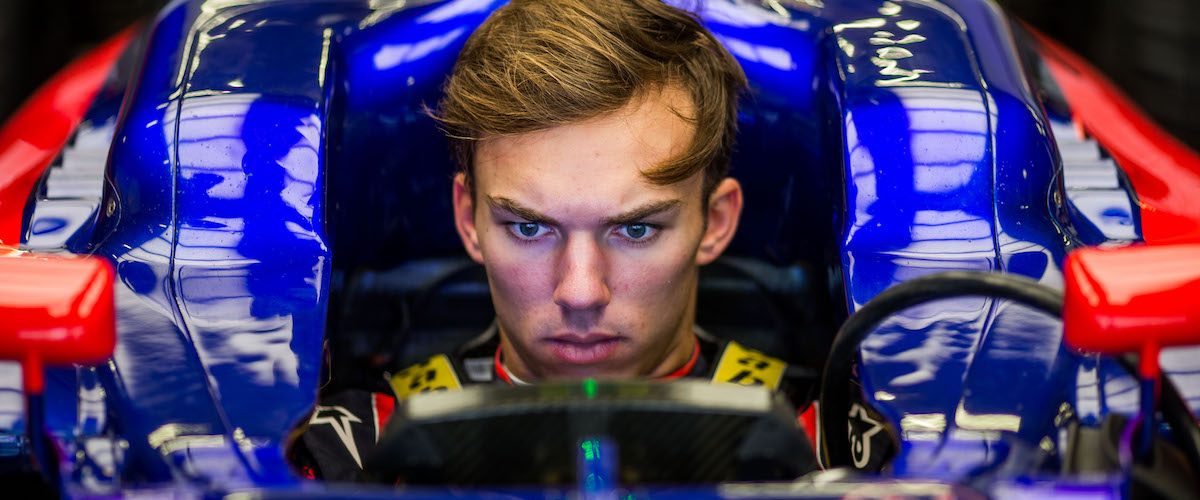Just as Lewis Hamilton wrapped up a fourth world drivers’ title by recovering to finish ninth following an opening lap collision with rival Sebastian Vettel, so Scuderia Toro Rosso drivers Pierre Gasly and Brendon Hartley can be proud of their battling efforts after a tough weekend.
“Never give up” seems to be the unsaid motto of Formula 1 drivers — something that we witnessed this weekend, and something that is also a core value here at Acronis. Engine changes and grid penalties for both drivers meant that it would be an almost impossible task to collect points from the back of the grid on race day but even so, both drivers produced mighty drives to almost pull off this unlikely feat. Brendon had charged to the periphery of the top ten before some issues with the engine and it was left to Pierre to bring home his STR12 in 13th, just behind the McLaren of Stoffel Vandoorne.
“With all the penalties, we had to start from the back of the grid and from there it’s very difficult to overtake and score points,” reflected team boss Franz Tost afterward. “Nevertheless, I must say that both Brendon and Pierre have done a good job – we have to take into consideration that they are new to the team and they were not able to complete as many laps as we had planned at the start of the weekend… They definitely made the best out of this situation!”
Despite a weekend that yielded no further points, it must be remembered that both drivers are in the embryonic stages of their careers at the pinnacle of motorsport. But like race winner Max Verstappen, both are products of the Red Bull driver development programme and have the ideal apprenticeship towards a career as a fully-fledged Formula 1 driver thanks to big brother Red Bull Racing.
Even so, with Pierre fighting it out in the Japanese Super Formula Championship for most of the year and Brendon having not driven a single seater since 2012 before Friday practice in Austin, stepping up to combat the extreme forces generated by the STR12 must have seemed daunting.
Just as well that Red Bull’s state-of-the-art simulator in Milton Keynes gives all every driver, including test and reserve driver Sean Gelael, the perfect learning tool with which to hone their skills.
All of the simulators are invaluable for learning the vagaries of new circuits such as Austin and Mexico City and all employ real F1 car chassis’ and 180 degree panoramic screens using three projectors with laser scanned track detail so the circuit is an exact replica of the real thing to within millimetres of the real thing, almost to within the last blade of grass by the trackside.
Everything is set up to the individual driver’s personal specifications, from the seating position, pedal settings and the current model of steering wheel. Even weight distribution, gear ratios, wing settings, suspension stiffness and fuel levels are all adjustable.
“In the sim we are doing many different things,” says Gasly. “Of course you have the development side, so we are testing many different technical things on the car and also for us it’s a great tool to get used to the track. The simulator is also really important because testing is limited so we are doing a lot of development work on the simulator and spending quite a lot of money to make it really realistic.”
The hydraulic rig itself on which the car sits is called a hexapod, and precisely replicates the movement of the car on the circuit itself with accurate roll, pitch and yaw. It is so realistic that the drivers won’t even notice the rig itself moving as they are so immersed with the sensation of driving a Formula 1 car even though it is three metres off the ground in Red Bull’s case. And when the driver starts his first laps, the car will behave exactly as the real car on the track would do, taking time for the tires and brakes to get up to optimum working temperature.
It all means that the cars will lap to within tenths of a second difference from the simulator to the first running of a new circuit in a real race car and drivers will already have a pretty good idea of the ideal racing line and braking points when they take to the circuit for the first time in anger.
“Of course it’s still simulation but it’s so advanced in terms of technology,” adds Gasly. “I can really be accurate on my feedback when I am in the sim. We can test a few things ahead of the race weekend in terms of car set up just to make sure we arrive with a good baseline there. And we can compare real data against simulator data so it’s really close to the real thing. It’s a simulator so it doesn’t move like a proper car but in terms of feeling it’s really close to the feelings we get inside a real F1 car.”
PlayStation it isn’t. When a driver leaves the cockpit of the simulator after a race distance simulation, he will have experienced exactly the same upper body workout as he would do in the real car proper.
“I always felt pretty good in the simulator but I remember from the past years some of my teammates in the lower series really felt sick and almost threw up after a session,” admits Gasly. “So it really depends on the person and the feelings you have in the sim.”
Acronis and Scuderia Toro Rosso are now looking forward to the second last race of the season in Brazil. It’s been an eventful year for both companies and it’ll be exciting to see how the “Never Give Up” attitude is going to shape the drivers’ success.
Image: Pierre Gasly of Scuderia Toro Rosso during the Formula One Grand Prix of Mexico, October 27, 2017. Source: Red Bull Content Pool.



